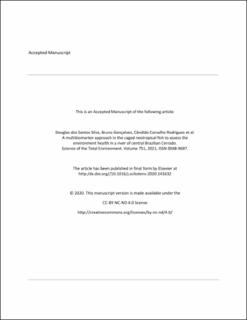| dc.contributor.author | dos Santos Silva, Douglas | |
| dc.contributor.author | Gonçalves, Bruno | |
| dc.contributor.author | Carvalho Rodrigues, Cândido | |
| dc.contributor.author | Cirqueira Dias, Felipe | |
| dc.contributor.author | Silvestre de Souza Trigueiro, Nicholas | |
| dc.contributor.author | Soares Moreira, Izabella | |
| dc.contributor.author | de Melo e Silva, Daniela | |
| dc.contributor.author | Maria Teixeira Sabóia-Morais, Simone | |
| dc.contributor.author | Gomes, Tania | |
| dc.contributor.author | Lopes Rocha, Thiago | |
| dc.date.accessioned | 2021-06-22T06:05:16Z | |
| dc.date.available | 2021-06-22T06:05:16Z | |
| dc.date.created | 2020-09-08T12:17:02Z | |
| dc.date.issued | 2021 | |
| dc.identifier.citation | Science of the Total Environment. 2021, 751, 141632. | en_US |
| dc.identifier.issn | 0048-9697 | |
| dc.identifier.uri | https://hdl.handle.net/11250/2760499 | |
| dc.description | Embargo until 19 August 2022. | en_US |
| dc.description.abstract | Water safety is a world-wide concern and several efforts have been made in order to ensure the conservation of aquatic ecosystems. Water quality monitoring must be performed with an integrated approach using biomonitor organisms allied to water parameters. Nonetheless, very few studies have focused on biomarker responses in neotropical fish, especially in the freshwater ecosystem of Brazilian Cerrado savanna. In present study, the active biomonitoring of the João Leite river (central Brazilian Cerrado river) was performed through the evaluation of biomarker responses in caged Astyanax lacustris in combination with land use classification and analysis of water parameters. Caged fish were exposed for seven days at four sites along the river and two control groups were kept in a tank under controlled conditions. Results showed that pasture was the predominant land use in the João Leite river basin (54.07%), followed by natural vegetation (34.92%) and other kind of land use (11.01%). Water analyses showed metal concentrations (Mn and Fe) above the maximum allowed by Brazilian regulation, with particularly higher concentrations at Site 2 (near to pasture area). Biomarker responses did not show significant differences for somatic and mutagenic biomarkers between sites. However, the comet assay showed high DNA damage at Sites 2 and 3, indicating genotoxic effects in caged fish at pasture areas. Histopathological analysis showed highest frequency of leukocyte infiltration in liver of fish from Site 2, confirming the ecotoxic effects on A. lacustris in streams impacted by grazing activities. DNA damage and leukocyte infiltration in fish hepatic tissues were sensitive biomarkers in the neotropical fish A. lacustris to assess the environment health of the Cerrado river. These results showed the importance of using a multibiomarker approach in environmental risk assessment, especially in areas more at risk from anthropogenic pollution. | en_US |
| dc.language.iso | eng | en_US |
| dc.publisher | Elsevier | en_US |
| dc.rights | Attribution-NonCommercial-NoDerivatives 4.0 Internasjonal | * |
| dc.rights.uri | http://creativecommons.org/licenses/by-nc-nd/4.0/deed.no | * |
| dc.title | A multibiomarker approach in the caged neotropical fish to assess the environment health in a river of central Brazilian Cerrado | en_US |
| dc.type | Peer reviewed | en_US |
| dc.type | Journal article | en_US |
| dc.description.version | acceptedVersion | en_US |
| dc.source.volume | 751 | en_US |
| dc.source.journal | Science of the Total Environment | en_US |
| dc.identifier.cristin | 1828063 | |
| dc.source.articlenumber | 141632 | en_US |
| cristin.ispublished | true | |
| cristin.fulltext | postprint | |
| cristin.qualitycode | 2 | |

